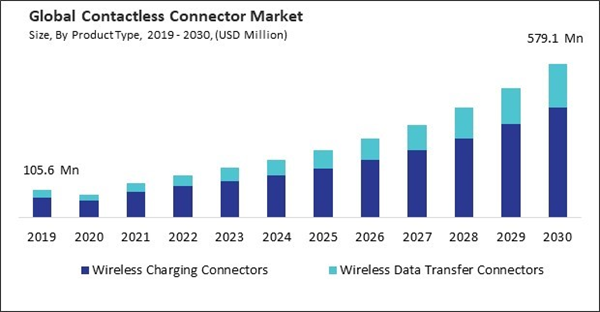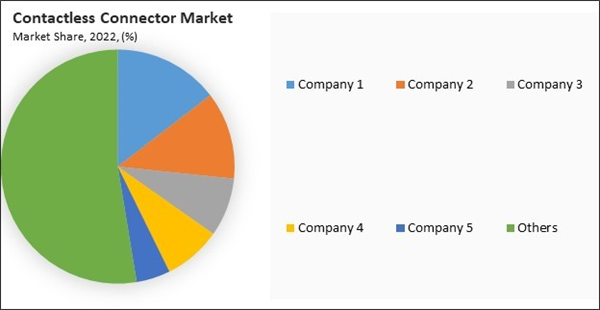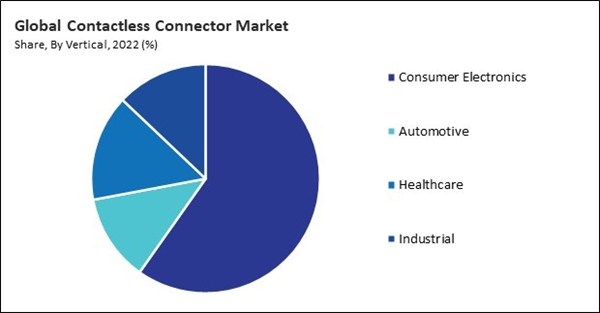The Global Contactless Connector Market size is expected to reach $579.1 million by 2030, rising at a market growth of 17.5% CAGR during the forecast period.
Healthcare systems in the Asia Pacific are transforming digitally, leading to increased adoption of these connectors for applications such as patient identification, telehealth, and remote patient monitoring. Consequently, the Asia Pacific region would acquire nearly 30% of the total market share by 2030. Additionally, The Asia Pacific region is a significant hub for the consumer electronics industry, including smartphones, wearables, and smart home devices. The Asia Pacific region is witnessing a rapid expansion of IoT devices across various industries.
Smart cities often implement intelligent transportation systems that rely on these connectors. Within smart buildings, these connectors play a role in energy management systems. These connectors facilitate communication between smart devices, sensors, and building management systems, contributing to energy-efficient lighting, HVAC (heating, ventilation, and air conditioning) control, and overall building automation. Therefore, the market is expanding significantly due to the smart cities and infrastructure development. Additionally, these connectors contribute to the flexibility of manufacturing systems by allowing for easy reconfiguration and adaptation. Implementing predictive maintenance strategies, a key aspect of Industry 4.0, relies on continuous equipment monitoring. Thus, because of the industrial automation and industry 4.0, the market is anticipated to increase significantly.
However, Small and medium-sized enterprises (SMEs) may have limited financial resources, making investing in high-cost connector solutions challenging. Small players and startups in the market may face challenges competing with established companies with the financial capacity to invest in and deploy high-cost solutions. Thus, high initial costs can slow down the growth of the market.
The leading players in the market are competing with diverse innovative offerings to remain competitive in the market. The above illustration shows the percentage of revenue shared by some of the leading companies in the market. The leading players of the market are adopting various strategies in order to cater demand coming from the different industries. The key developmental strategies in the market are Acquisitions, and Partnerships & Collaborations.
Healthcare systems in the Asia Pacific are transforming digitally, leading to increased adoption of these connectors for applications such as patient identification, telehealth, and remote patient monitoring. Consequently, the Asia Pacific region would acquire nearly 30% of the total market share by 2030. Additionally, The Asia Pacific region is a significant hub for the consumer electronics industry, including smartphones, wearables, and smart home devices. The Asia Pacific region is witnessing a rapid expansion of IoT devices across various industries.
Smart cities often implement intelligent transportation systems that rely on these connectors. Within smart buildings, these connectors play a role in energy management systems. These connectors facilitate communication between smart devices, sensors, and building management systems, contributing to energy-efficient lighting, HVAC (heating, ventilation, and air conditioning) control, and overall building automation. Therefore, the market is expanding significantly due to the smart cities and infrastructure development. Additionally, these connectors contribute to the flexibility of manufacturing systems by allowing for easy reconfiguration and adaptation. Implementing predictive maintenance strategies, a key aspect of Industry 4.0, relies on continuous equipment monitoring. Thus, because of the industrial automation and industry 4.0, the market is anticipated to increase significantly.
However, Small and medium-sized enterprises (SMEs) may have limited financial resources, making investing in high-cost connector solutions challenging. Small players and startups in the market may face challenges competing with established companies with the financial capacity to invest in and deploy high-cost solutions. Thus, high initial costs can slow down the growth of the market.
The leading players in the market are competing with diverse innovative offerings to remain competitive in the market. The above illustration shows the percentage of revenue shared by some of the leading companies in the market. The leading players of the market are adopting various strategies in order to cater demand coming from the different industries. The key developmental strategies in the market are Acquisitions, and Partnerships & Collaborations.
By Vertical Analysis
Based on Vertical, the market is categorized into consumer electronics, automotive, healthcare, and industrial. The healthcare segment acquired a 15% revenue share in the market in 2022. The rise of telehealth and remote patient monitoring drives the adoption of these connectors. Devices for remote patient monitoring, video consultations, and virtual healthcare services leverage contactless communication to facilitate remote interactions between patients and healthcare providers.By Product Type Analysis
By product type, the market is bifurcated into wireless charging connectors and wireless data transfer connectors. The wireless data transfer connectors segment covered a 25% revenue share in the market in 2022. Wireless data transfer connectors eliminate the reliance on physical connectors, reducing wear and tear on devices and connectors. This enhances the durability of devices and eliminates the need for users to carry various types of cables, simplifying the user experience.By Technology Analysis
Based on technology, the market is classified into inductive coupling, radio frequency, and magnetic field. The inductive coupling segment garnered a 36% revenue share in the market in 2022. Inductive coupling is utilized in industrial automation and robotics for wireless power transfer and communication between components. This application enhances the flexibility and efficiency of automated systems, allowing for seamless operation without the limitations of physical connectors.By Regional Analysis
Region-wise, the market is analysed across North America, Europe, Asia Pacific, and LAMEA. In 2022, the North America region led the market by generating 40% revenue share. The healthcare sector in North America is increasingly adopting these connectors for applications such as patient identification, telehealth, and remote patient monitoring. Retailers and financial institutions in North America are investing in contactless technology to meet consumer expectations for quick and secure transactions.List of Key Companies Profiled
- STMicroelectronics N.V.
- TE Connectivity Ltd.
- Molex, LLC (Koch Industries, Inc.)
- Rosenberger Hochfrequenztechnik GmbH
- Radiall SA
- Phoenix Contact GmbH & Co. KG
- Weidmüller Interface GmbH & Co. KG
- CommScope Holding Company, Inc.
- Sumitomo Electric Industries, Ltd.
- Eaton Corporation PLC
Market Report Segmentation
By Product Type- Wireless Charging Connectors
- Wireless Data Transfer Connectors
- Radio Frequency
- Inductive Coupling
- Magnetic Field
- Consumer Electronics
- Automotive
- Healthcare
- Industrial
- North America
- US
- Canada
- Mexico
- Rest of North America
- Europe
- Germany
- UK
- France
- Russia
- Spain
- Italy
- Rest of Europe
- Asia Pacific
- China
- Japan
- India
- South Korea
- Australia
- Malaysia
- Rest of Asia Pacific
- LAMEA
- Brazil
- Argentina
- UAE
- Saudi Arabia
- South Africa
- Nigeria
- Rest of LAMEA
Table of Contents
Chapter 1. Market Scope & Methodology
Chapter 2. Market at a Glance
Chapter 3. Market Overview
Chapter 4. Competition Analysis - Global
Chapter 5. Global Contactless Connector Market by Product Type
Chapter 6. Global Contactless Connector Market by Technology
Chapter 7. Global Contactless Connector Market by Vertical
Chapter 8. Global Contactless Connector Market by Region
Chapter 9. Company Profiles
Companies Mentioned
- STMicroelectronics N.V.
- TE Connectivity Ltd.
- Molex, LLC (Koch Industries, Inc.)
- Rosenberger Hochfrequenztechnik GmbH
- Radiall SA
- Phoenix Contact GmbH & Co. KG
- Weidmüller Interface GmbH & Co. KG
- CommScope Holding Company, Inc.
- Sumitomo Electric Industries, Ltd.
- Eaton Corporation PLC
Methodology

LOADING...











